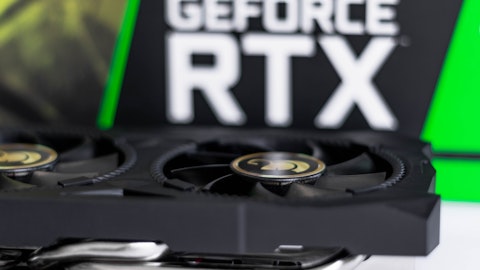We recently compiled a list of the 10 Best Beginner Stocks To Buy Now. In this article, we are going to take a look at where Microsoft Corporation (NASDAQ:MSFT) stands against the other beginner stocks.
While investing in the stock market carries risk, the US stock market is generally considered a safe place to invest. It has a long history of growth and has consistently recovered from downturns, including major recessions and financial crises.
Over the last four to five years, the market has been hit by several unexpected downturns, due to a global pandemic and the Russia-Ukraine war, among other things, that crippled the global economy. However, the US broader market recovered swiftly and has been performing well since 2023. It is nearly 19% up year-to-date, as of August 23.
Nevertheless, it is still a complicated place for beginners and they should consider investing in shares of well-established companies with a history of stable performance and reliability. These stocks typically belong to large, financially sound companies that operate in diverse industries, such as technology, consumer goods, and healthcare.
Additionally, beginners can also look into index funds or exchange-traded funds (ETFs) that track major market indices like the S&P 500. These options offer diversification, which reduces the risk associated with investing in individual stocks while still providing exposure to the broader market’s potential gains. Investing in such well-established and diversified assets can help beginners build confidence and knowledge in the stock market. For such ETFs, you can check out our article on the best large-cap growth ETFs.
Opportunities and Caution for New Investors Due to Consumer Behaviour
On August 16, Melissa Minkow, director of retail strategy at CI&T, discussed the latest trends in U.S. consumer spending in a CNBC interview. Despite concerns about a potential recession, Minkow believes we might have avoided one. She pointed out that although consumers may feel like they are in a recession, their spending habits show otherwise. They continue to spend, especially when presented with discounts. Retailers have adapted by offering more targeted promotions this year, which has helped maintain consumer spending despite previous challenges like the pandemic and supply chain issues.
Minkow also noted that the effectiveness of promotions can vary across sectors. For example, quick-service restaurants like McDonald’s and Starbucks haven’t seen the same benefits from discounts as other retailers, partly because consumers may opt for more cost-effective alternatives like home-cooked meals. Additionally, brands that are already positioned as discount options might not see as much impact from promotions. However, retailers who offer significant discounts on desirable items can attract cost-conscious shoppers and increase sales volume, potentially offsetting the impact on profit margins.
For beginner investors in the stock market, the current retail sector dynamics offer both opportunities and challenges. The resilience of consumer spending, even in the face of economic uncertainty, suggests that certain sectors and companies could continue to perform well, especially those that effectively use promotions to drive sales. Retailers offering targeted discounts on popular items may attract more customers, boosting their sales volumes, which could lead to positive stock performance.
However, beginner investors should also be cautious. Not all companies benefit equally from promotions, as seen with the restaurant and food segment, where discounts haven’t significantly improved earnings. This highlights the importance of understanding the specific business models and market positioning of companies before investing.
The Market is Healthy but Caution is Advised
The U.S. stocks have seen a significant surge over the last few quarters, which are mainly driven by strong economic data and optimism about a potential soft landing for the U.S. economy. However, experts remain cautious as we discussed in our best defensive stocks article.
In the article, we discussed the J.P. Morgan report that noted the market’s heavy reliance on large, high-quality tech and AI companies, and it warned that maintaining this momentum could be challenging due to high valuations and potential market volatility. Here is an excerpt from the article:
“According to a July report by J.P Morgan, recent market trends have benefited large, high-quality companies, especially in tech and AI, which have resulted in high market concentration. However, maintaining this momentum in the second half of 2024 could be difficult due to high valuations and investor positioning. The report says that while U.S. market volatility is currently low, it could rise if conditions change.
According to Bruce Kasman, global growth is steady at 2.4%, with improved recoveries in Western Europe and emerging markets, along with a rebound in the manufacturing sector. Despite this, core global inflation is projected to remain around 3% in 2024, which could limit the potential for policy easing. Kasman warned that achieving inflation control and rate normalization might weaken demand and could interact with political factors to cause further inflation and central bank tightening.”
Our Methodology
For this article, we used stock screeners to identify large to mega-cap stocks with a revenue compound annual growth rate of at least 5% over the last 10 years. The companies we chose are well-known, well-established, fundamentally strong, and some also pay regular dividends. We listed the companies in ascending order of their hedge fund sentiment as of the second quarter of 2024.
Why are we interested in the stocks that hedge funds pile into? The reason is simple: our research has shown that we can outperform the market by imitating the top stock picks of the best hedge funds. Our quarterly newsletter’s strategy selects 14 small-cap and large-cap stocks every quarter and has returned 275% since May 2014, beating its benchmark by 150 percentage points (see more details here).

A development team working together to create the next version of Windows.
Microsoft Corporation (NASDAQ:MSFT)
Number of Hedge Fund Holders: 279
10-year Revenue CAGR: 10.94%
Microsoft Corporation (NASDAQ:MSFT) is a prominent American multinational technology company. It runs through three main business segments, Productivity and Business Processes, Intelligent Cloud, and More Personal Computing.
The Productivity and Business Processes segment includes offerings such as Office Commercial, which covers Office 365 subscriptions and Microsoft Teams, and Office Consumer products like Microsoft 365 Consumer subscriptions. This segment also has LinkedIn and Dynamics 365, a collection of cloud-based applications designed for enterprise resource planning (ERP) and customer relationship management (CRM).
The Intelligent Cloud segment focuses on a range of server products and services, including public, private, and hybrid solutions. Major products of this segment are Microsoft Azure, SQL Server, and Windows Server, along with developer tools such as Visual Studio and GitHub.
The More Personal Computing segment features a variety of consumer-oriented products and services. This includes the Windows operating system, Surface devices, and Xbox hardware and content. It also includes search and news advertising through platforms like Bing and Microsoft Edge.
In the second quarter, 279 hedge funds held positions in Microsoft (NASDAQ:MSFT) and their stakes amounted to $89.068 billion. As of June 30, the Bill & Melinda Gates Foundation Trust is the most dominant shareholder in the company and has a position worth $15.6 billion.
Microsoft (NASDAQ:MSFT) is making significant strides in AI, a key area expected to drive future growth for the company. By partnering with OpenAI, the creator of ChatGPT, the company has strategically integrated advanced AI technology into its offerings. The recent fiscal fourth-quarter results highlight the impact of this focus as the Azure OpenAI service saw a 60% increase in customers year-over-year and reached 60,000. Additionally, the average spending per Azure AI customer is on the rise, which reflects the growing value businesses see in its AI solutions.
Beyond Azure, the company’s AI efforts are also flourishing across its other platforms. GitHub Copilot is already generating more revenue than GitHub did before Microsoft’s acquisition as per the company. Its Copilot AI assistant is now embedded in a range of products, from Microsoft 365 to Dynamics 365 and Power Platform. These integrations are driving transformation, particularly in Dynamics, where AI capabilities are improving business processes.
In terms of financial performance, Microsoft’s (NASDAQ:MSFT) largest revenue segment, the Intelligent Cloud, saw a 20% increase in the fourth quarter. This segment includes Azure, where AI services contributed significantly to this growth, accounting for 8% of the 29% year-over-year revenue rise in cloud services. The company expects that its investments in AI will continue to boost Azure’s growth in the second half of fiscal 2025.
Overall, the company’s focus on AI is not only enhancing its product offerings but also contributing to robust financial results. The company’s revenue for the fourth quarter was $245 billion, a 16% increase while operating income grew 24% year-over-year to $109.4 billion. With these strong financials and the ongoing expansion in AI, the company is one of the best beginner stocks to buy now as it capitalizes on the transformative potential of AI.
Baron Opportunity Fund stated the following regarding Microsoft Corporation (NASDAQ:MSFT) in its Q2 2024 investor letter:
“Microsoft Corporation (NASDAQ:MSFT) is the world’s largest software and cloud computing company. Microsoft was traditionally known for its Windows and Office products, but over the last five years it has built a $135 billion run-rate cloud business, including its Azure cloud infrastructure service and its Office 365 and Dynamics 365 cloud-delivered applications. The stock contributed to performance because of continued strong operating results and investor enthusiasm regarding Microsoft’s leadership across the secular megatrends of AI and cloud computing. Recent business momentum continued to show evidence of the strength and attractiveness of Microsoft’s product portfolio among its customer set: (1) Azure OpenAI – its suite of AI services – is now used by 65% of the Fortune 100 and contributed 7% of Azure revenue (an annualized run rate of $5.2 billion); (2) GitHub Copilot – its AI code writing service – is bending the productivity curve for developers (reports of 40%- plus improvements in developer efficiency) and now has 1.8 million paid subscribers, with growth accelerating to over 35% quarter-over-quarter; and (3) Copilot Studio – its AI application service that makes it easier for anyone to build an application, automate a workflow, or create a Copilot using natural language. 30,000 organizations across every industry have used Copilot Studio to customize Copilot for Microsoft 365 or build their own, up 175% quarter-over-quarter. In the March quarter, Microsoft again reported better-than-expected financial results, highlighted by Microsoft Cloud growing 23% year-over-year, with the fastest commercial bookings in six quarters, and Azure accelerating to 31% constant currency growth, up from 28% in the previous quarter. June quarter guidance came in-line with consensus, but the company provided higher guidance for the most important segment, Intelligent Cloud, on the back of continued strong trends across Azure and Azure OpenAI. We remain confident that Microsoft is one of the best-positioned companies across the overlapping software, cloud computing, and AI landscapes.”
Overall MSFT ranks 1st on our list of the best beginner stocks to buy. While we acknowledge the potential of MSFT as an investment, our conviction lies in the belief that AI stocks hold greater promise for delivering higher returns and doing so within a shorter timeframe. If you are looking for an AI stock that is more promising than MSFT but that trades at less than 5 times its earnings, check out our report about the cheapest AI stock.
Read Next: $30 Trillion Opportunity: 15 Best Humanoid Robot Stocks to Buy According to Morgan Stanley and Jim Cramer Says NVIDIA ‘Has Become A Wasteland’.
Disclosure: None. This article is originally published at Insider Monkey.





